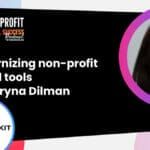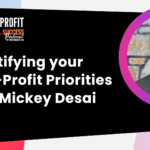Video recording
Audio recording
Dive into our newest episode of the Non-Profit Digital Success Podcast, where we’re joined by Samantha Lloyd, co-founder and managing director of Skeleton Krew. Samantha shares her expertise in maximizing digital content creation for non-profits, even when resources are tight. Learn about leveraging evergreen content, utilizing free tools, and enhancing online visibility to make a significant impact with tight budget.
This episode is a must-listen for any non-profit looking to boost their digital marketing strategies without stretching their budget. Tune in for actionable insights and practical tips to transform your organization’s online presence!
Mentioned Resources
Episode Transcription
David Pisarek: If you are working on a shoestring budget, if you have almost no money to put towards your digital growth, you’re going to want to tune into this episode. So stay tuned.
Samantha Lloyd: Sounds good.
David Pisarek: Welcome to the Non-profit Digital Success Podcast. I’m your host, David. And in this episode, we’re going to be talking about how you can still get amazing awareness and growth for your non-profit with Samantha Lloyd. Samantha is the co-founder and managing director of Skeleton Krew, acting as marketing director for B2B companies.
Samantha is a marketing expert and advisor who supports start-ups in early-stage growth. She’s got over a decade of experience building organic growth, brand and digital marketing for startups and technology companies. Welcome, Samantha.
Samantha Lloyd: Awesome. Thank you so much, David. Thank you for hosting me.
David Pisarek: So in the past, you mentioned that you’ve volunteered with children who experience disabilities as well as Habitat for Humanity. Do you want to talk about your experience with that?
Samantha Lloyd: Yeah, so I’ve been fortunate enough to participate with some volunteer organizations just in a small capacity. And I have a lot of respect for people who work in the non-profit space, obviously.
As we talked about previously, there’s a lot of time dedicated to volunteers, not just in making the volunteer organization run, but also having the non-profit aspect be successful. And that can often include them participating in a lot of things like marketing and sales, which are very time-consuming and can be budget-heavy activities. So a lot of respect for people who work in those spaces because it is hard work.
David Pisarek: Amazing. So what are some interesting marketing strategies that non-profits or charities can leverage to maybe save money?
Samantha Lloyd: Yeah, for sure. So as you know, often marketing tactics are divided between time investment and financial investment, and then there’s some that, of course, “Take both.”
But what we want to push always when you have a smaller budget is to do the time investment where possible.
So one of the favourite strategies I have when you’re starting out, is you could be a startup with a smaller budget, or you could be a non-profit with almost no budget to dedicate towards marketing. One of the best ones is content and distribution.
So again, this is a lift and a lot of people do feel nervous about writing, but I would say just get started. Maybe don’t be shy to try using an AI tool to support you if you need it. But there’s nothing like a person who’s really passionate about what they’re doing writing about it, even if you don’t think that it’s up to the technical chops that your passion comes through.
So I would recommend having a blog and dedicating your time to posting just one blog post a week. If you have multiple team members, maybe you can do more than that, or maybe you can trade off with your team members on who can do what week, but that would be my minimum recommendation.
And then, of course, we all know content without distribution is like having a billboard in your basement. So what you want to do there is try to get your content out. And this could be on social media, so just organic posts. You could do email marketing to your list of prospects or existing donors, which again, you can use Mailchimp or other services that allow you to do that for free up to a certain list amount.
And then from a distribution perspective, we can get into that more. But the solid goal there is just to ask. Ask publications to host you, and ask other partners to post content about you. And that’s the main things that you can do that are free, but definitely a time investment.
David Pisarek: In terms of the content, I made a little note as you were talking, I’ve got this wall on… If you’re watching the video of this, awesome, you can actually see this. If you’re not watching the video, go to our YouTube channel or go to our show notes page, you’ll see this. On the wall behind me, I’ve got this board and this is our content calendar.
We do this with our clients as well. You can create content on a weekly basis. You should create content at a minimum once a week. What does that content have to be? 400 words? 500 words? We’re not looking for a massive PhD, dissertation, or anything like that. It doesn’t have to be very technical. It doesn’t have to be scientific. It just has to talk about… There are a few things here. What are questions that people ask you? What are questions that people ask the staff or volunteers? What are the popular pages on your website? Create content around that.
It’s super easy to find ideas and to come up with ideas. You can talk about the impact, the people that you’ve helped recently, and an event that’s coming up.
There are all kinds of different ways that you can brainstorm coming up with content. So let your passion come through. I love that you mentioned that, Sam. Be authentic with it. Not everything has to be 100 % perfectly written from professional writers all of the time. I know in the ideal world that would be the case, but it’s okay.
Samantha Lloyd: Yeah, that’s great advice, David.
David Pisarek: All right, so there’s publishing content. The added benefit of that is Search Engine Optimization. You’ll get more visits from search engines and people organically finding you over time, which is awesome. Are there any other low-cost efforts that people can do?
Samantha Lloyd: For sure. So Facebook is a really good channel for non-profits to pursue in order to increase their donors.
So Facebook ads you can typically run for a fairly low cost. It is an ads platform where you can even experiment for a bit of a lower cost just to see how the audience is receptive.
If it did increase your site traffic, if it did increase your contribution to the pipeline. So Facebook is one that I would recommend. You can honestly do an ad to a lookalike audience to your existing one, test it for just $100, just see how it performs. And that’s a recommendation that I would give there.
Other low-cost ones, again, sit in that content umbrella where you can go to publications and see what their costs are. Some publications, of course, let you host for free. Others are in the couple of $100 range. And then, of course, you have many that sit in the thousands. But there are publications that are inexpensive and you don’t have to go for ones where you think I need traditional media or the newspaper to report on me.
You can go for publications that are about non-profits. You can go for publications that are about social good. You can try to find really niche publications where maybe the cost is a bit lower to participate, but the audience will be hyper-targeted to ones that are the right fit for you.
David Pisarek: Another easy win is adding a donate button to your Facebook page. You have to be listed with them as a proper non-profit. They can actually add a donate button right there.
Samantha Lloyd: That’s awesome. That’s a really good one. Anything where you can make it easier as you know and just remove steps, it’s always going to be a win.
David Pisarek: If you can produce some video content for your non-profit, what do you have to say about that?
Samantha Lloyd: Sure. So for video content, you want to basically create something that can be reusable across many platforms. So you don’t want to film something where you’re like, “This is only suitable for a television ad,” or “This is only suitable if we can use small clips on Instagram.” You want something where those pieces can be reused across all your social channels to get the most spread from it.
When you’re doing video content, you can do it for a lower cost. Of course, if you have someone talented that you know for filming, that would make a big difference. The videos that are typically going to cost you a bit more money is where you do maybe those explainer videos that are animated or you need someone with that skill set to build out the entire video.
If you are filming and you happen to have access to a high-quality camera on your phone, maybe you have a high-quality microphone because sound quality does have a huge impact on video engagement, then those would be channels that you can pursue.
The best way is to write a script in advance, work on that with your team, get your team involved locally and try to film something and leverage those pieces across social on your organic channels.
David Pisarek: I think certainly during COVID, it pivoted video creation and what people come to expect out of the video. And a lot of people are okay with just having somebody film themselves, like selfie video style with their phone.
If you have a little bit of budget, I’m talking like $100 at max, go on to your favourite online shopping site, maybe Amazon, for example. I’ll put a link in the show notes and pick up a gimbal for your phone.
So what is a gimbal? It controls your phone and prevents it from wiggling as you’re talking about it. I’ve got one actually and this if you’re all right, again, if you’re watching this, you’ll see what this is. But basically, it’s a little device that you can hold. You can put your phone in it and it will keep it stable as you’re using it. You don’t have to worry about like shaky hand or anything. This will take care of all that.
There are motors in there that stabilize all of that for you and just make it really, really easy to create a video that’s maybe just slightly more professional than shaky hand.
Samantha Lloyd: Yeah, that’s awesome. I didn’t know about that product. That’s a really cool one.
David Pisarek: Yeah. Did you get decent ones for $60-70? You could pay a little bit more $120, you can connect with Bluetooth, all kinds of stuff. But as long as it will hold it and it’s motorized, so it needs a power source for it, it’ll allow you to control it and have it super stable when you’re recording.
Samantha Lloyd: Yeah, that’s great.
David Pisarek: Yeah. Okay, so video, awesome. I tend to say video really grabs people’s attention.
Video is the new photo. If a picture can tell a thousand words, video is like 10,000 words. So 10 million words, whatever. It’s so much more impactful. You can actually give more information, tell more of a story, and connect with people.
You’ve probably noticed that as you scroll through your Facebook or your Instagram or whatever it is that you’re looking at if a video pops up, it’s going to grab you for a second, right? So that first bit of the video has to be really impactful and eye grabbing.
Samantha Lloyd: Definitely.Yeah.
David Pisarek: All right. So that’s, I guess, a little bit of what I would categorize under content marketing. Do you have any other tips around content marketing for non-profits?
Samantha Lloyd: Yeah. So I mean, for content marketing specifically, a good piece of advice is always just if you’re going to write content, try to write something that’s called Evergreen. So that means content that is not necessarily on the top trend but is something that anyone can come read at any point in time and it’s still relevant.
So that’s some advice that will help your content at least continuously rank in SERPs and be useful to your audience.
Always try to provide value in your content. So if you’re trying to tell somebody about something, give them the best advice possible.
What is the value you would want to get out of this piece of content? So make something that is really supportive of what people are searching for.
The other thing, of course, is Google keywords; it’s free, so you can go on there, find the keywords, and look for the ones that have lower competition. That means fewer people are bidding on the terms, but have, of course, the highest traffic for that competition level.
And then Google Trends is another one. If you are trying to write trendy content, that’s another free resource where you can see, “Okay, what’s been trending a lot the last little bit?” Try to leverage those trends where they make sense for your non-profit.
David Pisarek: I think it’s important for people to understand the importance of having content on your site. We need to be out there. We need to get into publications and get links back to our site. Those are called back-links. Google looks at those as really amazing things, depending on the site that they’re on.
Part of the other algorithm piece that a lot of people don’t really think about or talk about is that Google wants to see pages that are updated over time. So if there’s an article that you published on your site maybe 3, 4, 5, or 10 years ago and you’re still getting traffic to it, make some updates to it and put an “Updated on” with the date. And Google is donna pick that up and go, “Oh, okay. Yeah, these people, they care about their content, they’re updating stuff”, and you’re going to get more organic traffic. You’ll rank higher in search engines, result pages, and SERPs. That’s really going to help you out.
Samantha Lloyd: Exactly. Yeah, that’s great advice. Anything that can get your site crawled regularly, such as adding content or updating content is very important. And that lesson also applies to local search.
So if you’re on Google Maps with your non-profit, continuously making sure that you’re getting reviews on there, updating the information, and adding new images that will again help with the ranking on Local Search, just as it would apply to content on your own site.
David Pisarek: 100%. And get people who work for your organization, volunteers, people that come and use your services or your programs, whatever it is that you’re doing, ask if they can go on to Google and give you a review. It doesn’t have to be a five-star. It’s actually scientifically proven, psychologically proven that if you have a five-star rating, people don’t see it as authentic as the 4.8.
Samantha Lloyd: Yeah, there’s a meme about that where it’s like 80 people rated five stars… “Suspicious”, but 1,000 people rated 4.5 and you’re like, “I’m in.”
David Pisarek: Right, exactly. So let’s use that. Not everything is perfect. We’re not perfect as humans, we’re not perfect as organizations, despite how much we try and how much we want to be. That’s part of the authenticity that needs to come through.
Samantha Lloyd: Yeah, it’s all right. Of course, if you’re sitting lower than five stars, that’s perfectly acceptable. Everyone’s gone to a restaurant that’s under five stars as normal. And yeah, getting people to speak honestly about their experience is much more important.
The way to get more volunteers is to have volunteers review and leave their honest experiences.
That way you’ll get more volunteers who know what to expect coming in and will be able to perform their best for that.
David Pisarek: 100% and part of that is about distribution. So we can write content, we can have it on our site. I mentioned briefly about getting out there and having your stuff on other sites. What are your thoughts about that?
Samantha Lloyd: You definitely need that. It’s my favorite part of SEO in general, is just having the off-page content. A, it lets you reach a new audience often when you write content for even just another website’s blog that has a similar audience. They might put it on their social media. They might put it in their email newsletter. You’re getting a lot of targeted spread that way.
So short of just the backlink, which is obviously incredibly valuable if you’ve done your anchor text properly and like you said, it’s on a reliable domain, you’re getting further distribution just from their team marketing your content. So if you have the capacity to write off-page content, I would highly recommend trying to find two or three places a month where you can participate in off-page content.
David Pisarek: I think that’s amazing advice. So everybody that’s listening to this, go and do that. Finish listening to the episode, then go and do it.
Samantha Lloyd: Yeah, you just have to ask. I feel like a lot of people aren’t aware that the reason I’m on this podcast is because my team asked.
You just have to go out there, find places where you feel you add value and just ask, “Hey, can I participate?” And then also offer the opportunity to participate back. Maybe you wanted to post on a non-profit blog that has a similar target to yours and offer your blog back to them. Say you’ll feature them in your newsletter and your social, so make it a true marketing partnership.
David Pisarek: I think that’s the key. You can’t always just be out there asking you need to give them something in return. It really is about partnerships and coming together. Find podcasts that you can get on that are going to get you in front of people who are your audience, people who will care about you as an organization that might be empathetic to your cause. They’re out there.
Samantha Lloyd: Exactly.
David Pisarek: Okay, so we talked about creating content. We talked about all kinds of different content. We talked about distribution and getting out there and where you can publish and all of that. I think that’s really awesome. But what advice do you have for people to figure out how to track the KPIs, the metrics, the performance of the effort that they’re doing?
Samantha Lloyd: For sure. So tracking can be a more expensive thing to participate in.
So say, for example, maybe you’re doing this very inexpensively right now, so you just have Google Analytics in place. You have your form, people come through email. Maybe you make a list in Google Sheets or Excel, and you’re doing it very manually like that to track everything.
When you start exploring like the CRM side where your form is attached to a sales machine that you log into and you see everyone and you can track their pipeline and you can track their attribution using HubSpot or Salesforce, that is where it gets more expensive. So you have to decide if that’s the right fit for you on those types of platforms.
Usually, the more users you start getting through, the more it costs you. So it can be something that scales to quite expensive over time. The best way if you can’t invest in that is to just try to do it manually. So I would recommend Google Analytics.
I know that there’s a lot of talk. We all don’t love GA4, unfortunately. And for a lot of my clients, for example, we’ve actually switched to paid analytics tools as an alternative to losing universal analytics, which is unfortunate. But GA4 at least, will give you a base understanding, not as much depth.
You’re definitely lacking attribution, but that is the option I would say, habit rather than not always. Google Search Console is also free and hopefully will still remain as is. I’m not sure if it will be changed with GA4. I’m going live in July, but of course, the Google Search Console can give you more hints on your keyword success and your backlinks, which is free.
So yeah, it’s really hard to track attribution, I think, granularly if you are using free tools, but put in Google Analytics for now. Start tracking what’s working, the content that’s picking up, and what social channels people are coming from. And then that can let you decide where to invest or if you need more granular tracking to really understand your attribution.
David Pisarek: There are things you can do in Google Analytics, so you can create some custom event tracking and things like that. You can get more details out of it, but it’s not for the average person.
You really do need some support around that to actually get to the data or to build some custom reports around it so that you can get to the data that is going to be most beneficial for you or easy to understand.
Samantha Lloyd: Yeah, it’s unfortunately a little harder for the average person who’s not familiar with marketing operations to be able to just set up Google Analytics and run with it, which I think is unfortunate. I always think that Google Analytics is everyone’s gateway into marketing. You see that and you’re like, “Wow, okay, this is what’s working.” And it makes them really excited and gets people interested in marketing in general for their business. So yeah, GA4 I think shut that down. Shut down the love.
David Pisarek: It’s not as great, I’ll admit. There are some cool things in there like you can just search for whatever it is you’re looking for and it’ll give you that.
Samantha Lloyd: Yes, the search is nice.
David Pisarek: It’s pretty neat. There’s another site out there. It’s owned by Neil Patel from NP Digital. The site is called Answer the Public. I don’t know if you’ve heard of this before.
Samantha Lloyd: I haven’t heard of his Answer the Public, no.
David Pisarek: Okay, basically you can go. In the free tier, you can submit two queries a day. Okay, fine. So you can put in homelessness, for example, as a word. It takes a little bit, maybe 45 seconds or a minute, and it’ll come back with questions that people are actually using in search topics around that idea of homelessness. Like, “Oh, okay, this is what people are looking for. Cool. Let’s create some content around this. Let’s use this to help generate our content schedule, our content calendar for the next three months.” And you can use that really, really easily and simply just by going and doing a search.
Samantha Lloyd: Very cool. I’m going to look at that after.
David Pisarek: I will put a link in the show notes for everybody.
Samantha Lloyd: Yeah, so I could look at it. But the interesting thing too is when you see people’s search queries and they’re actually questions, you can use that exact question for your content piece. It’ll actually help promote it into the snippets or the recommended questions. So definitely if you have a question and you’re basically answering it in the blog, that is a recommended tactic as well.
David Pisarek: I would say you started off by saying you can. I would say you should use that question, as the actual title of your article, your page, whatever it is that you’re producing. In your opinion, Samantha, how can people save time on these types of marketing tasks?
Samantha Lloyd: Yeah. So I ask myself that every day because I’m also looking to save time on that. One of the best things you can do, of course, is to rally your organization, like we talked about to get people to write.
For the others, if you have a bit of budget, there are content writers who specifically work with non-profits and they work at a lower cost. So trying to search out those writers can be supportive. They also then understand your brand and the message that you’re trying to put out to attract an audience.
So search for content writers who specifically work in this space if you have a budget.
The app from a time perspective: try to choose a site that is just really easy to work with. So I am an affiliate partner of theirs, but I’m obsessed with Webflow. Webflow is really easy to learn. So if someone can build you a site or if you can just use a template and make your own site, which there’s a lot of free templates there, so you could.
I would recommend making yourself a CMS one, and then you’ll be able to publish content ongoing. I know that some use WordPress as well, and some people have complications with it, some people love it. So it just depends.
You have to find a web platform that makes it as easy as possible for you. If publishing the content takes a long time, you’re just never going to do it. So it has to be as easy as possible.
David Pisarek: I’m going to do one small self-promo plug here, which is my agency, Wow Digital, we created a platform called MightyNPO. So mightynpo.com, template-based, you pick it, we do everything for you. So if you don’t have time, my team will do everything. If you need something put on the site, you let us know, we deal with all of it for you. It’ll save you a ton of time and effort.
Okay, cool. So, Samantha, it’s been awesome having you on the show here. Amazing conversation around awareness and growth. I hope the people who have been listening are not too overwhelmed because I think we’ve talked about a bunch of stuff here. I like to usually issue a challenge to everybody who listens to the episode. Is there a challenge that you have for anybody?
Samantha Lloyd: Yes, my challenge will be along the lines of everything we’ve been talking about today, which is just ask.
So if there is an award that you want your non-profit to qualify for, if there’s a content publication you’ve always wanted to be featured on, if there’s a podcast you wanted to be on, go now and ask and fill in the application and see where it lends you.
David Pisarek: I love that. I think that’s amazing. I’ve said it on a number of episodes before, you need to actually take the first step. Going and asking that is the first step. But you don’t know if you don’t try. Amazing. If anybody wants to get in touch with you, what do they need to do?
Samantha Lloyd: Yeah. So if you want to get in touch, of course, I’m on LinkedIn under Samantha Lloyd. As David said, I’m the Managing Director at Skeleton Krew Agency, and that’s Skeleton Krew with a K. So if you look that up or you find me on LinkedIn, please feel free to connect. And yeah, thank you so much, David. This is a blast.
David Pisarek: Thanks so much, Samantha. It’s been great having you on the Non-profit Digital Success Podcast.
To everybody listening, as I mentioned before, if you want any of the links or the resources that we spoke about today, head over to our podcast page at nonprofitdigitalsuccess.com. Click on this episode for all the details. And until next time, keep on being successful.














0 Comments